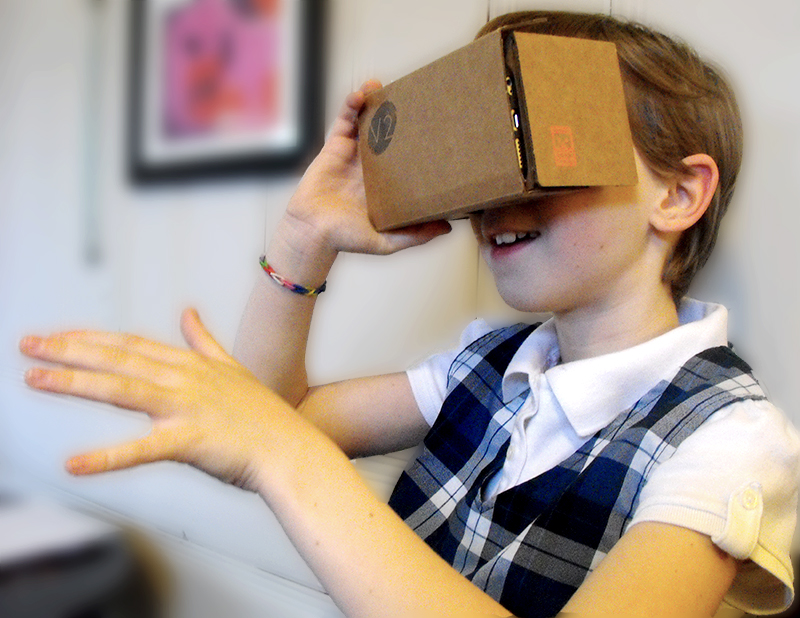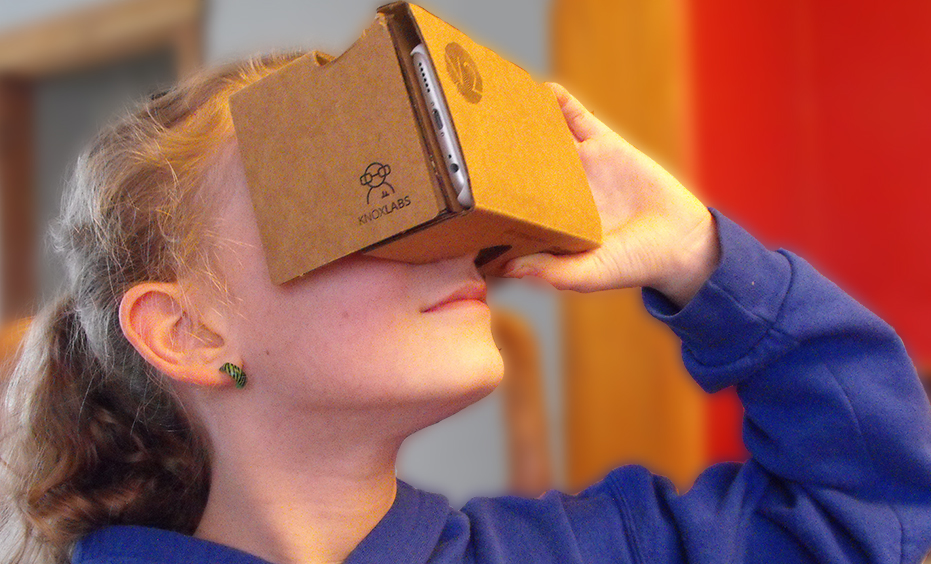
Virtual Reality (VR) is bursting onto the commercial market like a freight train. Facebook recently bought the VR company Oculus Rift, the New York Times has begun using VR to transport readers into the heart of a news story, and Google has introduced us to the world of Google Cardboard.
Google Cardboard are inexpensive, build-it-yourself goggles made of cardboard that let users explore VR apps right on their smartphones. The process is simple: download one of the many available virtual reality apps onto your phone, place the phone in the designated slot on the Cardboard viewing portal, and look through the lens to start your experience. The result is complete immersion in a place (like the Grand Canyon) or experience (such as touring a museum). In this three-dimensional world, you can look all around by moving your head just as you would if you were standing in the physical space.
This technology, which is making a splash for personal entertainment, is also being harnessed for educational purposes to enliven the classroom and make learning more experiential at a low cost.
Education
In the past decade, teachers have started trading in brick-and-mortar education for virtual classrooms, spiral notebooks for tablets, and blackboards for Smartboards. Now, thanks to Google, teachers are also swapping traditional lessons with fully immersive virtual reality experiences.
In education, the benefits of Google Cardboard have already been far-reaching. Teachers are implementing the devices into their history and science classes to send students into the time and place they are studying. Instead of looking at grainy textbook photos of Rome, students can download Google Street View to step inside the Colosseum. A discussion on diversity can be enhanced by downloading the NYT VR app and allowing students to be part of the November 2015 Paris vigils. The possibilities are endless as new apps continue to be developed. DePaul Associate Professor in Elementary Math, Nell Cobb, believes that the prospects for use in the classroom extend to math concepts as well. "Specifically, in a mathematics classroom, students could explore geometric and algebraic applications. One example would be to have students explore relationships between two-dimensional and three-dimensional objects," states Cobb. With so many uses, and at a cost of $20-30, many schools are able to find room in the budget to order them for entire classes of students.

Google has taken the experience one step further by creating the
Expeditions Pioneer Program, a classroom-specific platform. Schools enroll in the free program and, if selected, the Expeditions team travels to the chosen school to demonstrate for teachers how to set up a learning-based experience with Cardboard. The program has over 100 “expeditions” to choose from, which allows teachers to customize the experience to their curriculum. At Horizon Community Learning Center in Arizona, students “traveled” around the world with help of the Expeditions program. As they explored countries like Italy and Brazil, the teacher read to them location-specific talking points, which were provided by the Expeditions team. At Whiteaker Middle School in Oregon, students toured famous castles with the help of Expeditions. Students “took in views from turrets, found secret passages and discovered the hidden room where royalty would listen in to the conversations of guests.” (
WMS pioneers Google Cardboard). This effectively provided a “real-world” component to a traditionally textbook- or lecture-driven social studies class.
Cardboard also has allowed students to attend virtual class trips, in lieu of physically traveling to a destination. In schools that have
low funding or are unable to raise enough money to cover transportation, hotels, and excursions for a class of students, Cardboard provides an alternative that is both stimulating and educational. Cardboard is even influencing the college search process. Erin Mason, DePaul Associate Professor in Counseling, explains "As someone who supports the preparation and training of school counselors, I’m especially excited to learn that the First Lady has partnered with Google Expeditions to use Google Cardboards for virtual college tours.” While the virtual trips still lack the tactile exploration and the cultural immersion that an in-person trip provides, it still allows students to see the world around them in a way that was previously only available in two dimensions.
Science & Medicine
Beyond the classroom, Cardboard has also served as an educational tool for medical professionals. At Nicklaus Children’s Hospital in Florida it helped save the life of newborn baby Teegan who was both with a heart and lung defect. With little hope on the horizon to save Teegan, doctors used Cardboard and downloaded images of her heart to view it from multiple angles. Visualizing the heart in this way helped the surgeons discover that they could, in fact, fix her. Teegan survived because of the Cardboard technology and the innovative thinking of a doctor. At the University of Arizona, developers have prototyped BrainGainz, which would allow NCAA athletes and soldiers to virtually experience concussion symptoms. Having the virtual experience, they believe, will help them recognize symptoms in a real-world situation so they can immediately seek treatment.
Entertainment
Of course, Cardboard doesn’t isn’t just about learning or exploration. As virtual reality becomes more popular, apps of all kinds are filtering into the entertainment market to give users virtual experiences they may not get to experience in reality.
Want to feel the thrill of the rugged outdoors or attend a concert from a Beatles legend? The Jaunt app allows you to rock climb or base jump in a variety of venues including Moab, Utah and Yosemite National Park or get front and center to a 360-degree performance of Sir Paul McCartney's "Live and Let Die". Likewise, you can jump on board a roller coaster with Roller Coaster VR and not only fly upside down through a loop, but also gaze around at the scenery at the top of the coaster. Interested in more otherworldly thrills? The Sisters app allows you to step into the middle of a true horror experience made for mobile virtual reality. These entertaining apps, and others, continue to populate the Apple and Google Play stores as demand rises and possibilities abound.
Courtney Bregar is an Instructional Technology Consultant in the DePaul College of Education's Center for Educational Technology (CET). CET helps faculty members explore new ways to bring technology to the classroom. With a focus on emerging educational technology, the CET strives to bridge the learning gap and engage students through various hardware, software and applications.